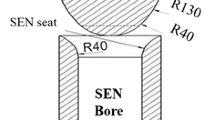Abstract
Flow injection in center-gated disks was experimentally studied in this paper for possible applications in the manufacturing of composite materials in space. The experimental set-up used in this study was designed to provide flow visualization of the mold filling process. To record the progression of the fluid flow front in the mold, the experiment was filmed using a CCD. The effects of gravitation and surface tension on the development of flow front progression and front shape were examined for a wide range of the governing parameters (namely, the capillary and Stokes numbers). It has been found that surface tension tends to hold the flow front in symmetric shape while gravitation tends to distort it. The balance of these two forces has significant effects on the progression of the flow and the front shape. Results obtained from this experimental model not only validate the finite element method (FEM) model thus developed but also provide useful information in the design of the resin transfer molding process in space.
Similar content being viewed by others
References
Tadmor Z, Broyer E, Gutfinger C (1974) Flow analysis network (FAN) – A method for solving flow problems in polymer processing. Polymer Eng Sci 14:660–664
Hieber CA, Shen SF (1980) A finite element/finite difference simulation of the injection molding filling process. J Non-Newtonian Fluid Mech 7:1–32
Hieber CA, Socha LS, Shen SF, Wang KK, Isayev AI (1983) Filling thin cavities of variable gap thickness: A numerical and experimental investigation. Polymer Eng Sci 23:20–26
Chiang HH, Hieber CA, Wang KK (1991) A unified simulation of the filling and postfilling stages in injection molding. Part I: formulation. Polymer Eng Sci 31:116–124
Spencer RS, Gilmore GD (1951) Some flow phenomena in the injection molding of polystyrene. J Colloid Interface Sci 6:118–132
Rose WR (1961) Fluid-fluid interfaces in steady motion. Nature 191:242–243
Schmidt LR (1974) A special mold and tracer technique for studying shear and extensional flows in a mold cavity during injection molding. Polymer Eng Sci 14:797–800
Huang CF (1978) Simulation of the cavity filling process with the marker-and-cell method in injection molding. Dissertation, Stevens Institute of Technology, Hoboken, NJ
Wang KK, Shen SF, Cohen C, Hieber CA, Jahanmir S (1978) Computer-aided injection molding system, report 5. Cornell University
Wang KK, Shen SF, Cohen C, Hieber CA, Isayev AI, Jahanmir S, Tayler A (1979)Computer-aided injection molding system, report 6. Cornell University
Mavridis H, Hrymak AN, Vlachopoulos J (1986) Finite element simulation of fountain flow in injection molding. Polymer Eng Sci 26:449–454
Behrens RA, Crochet MJ, Denson CD, Metzner AB (1987) Transient free-surface flows: motion of a fluid advancing in a tube. AIChE J 33:1178–1186
Mavridis H, Hrymak A, Vlachopoulos N (1988) Transient free surface flows in injection mold filling. AIChE J 34:403–410
Fauchon D, Dannelongue HH, Tanguy PA (1991) Numerical simulation of the advancing front in injection molding. Int Polymer Process 6:13–18
Shin S, Lee WI (1995) Analysis of the non-isothermal mold filling process using finite element method. J Mater Process Manuf Sci 3:333–357
Sato T, Richardson SM (1995) Numerical simulation of the fountain flow problem for viscoelastic fluid. Polymer Eng Sci 35:805–812
Coyle DJ, Black JW, Macosko CW (1987) The kinematics of fountain flow in mold-filling. AIChE J 33:1168–1177
Gresho PM, Lee RL, Sani RL (1979) On the time-dependent solution of the incompressible Navier-Stokes equations in two and three dimensions. In: Taylor C, Morgan K (eds) Recent Advances in Numerical Methods in Fluids. Pineridge, Swansea, UK 1:27–79
Slikkerveer PJ, Van Lohuizen EP, O’Brien SB (1996) An implicit surface tension algorithm for Picard solvers of surface-tension-dominated free and moving boundary problems. Int J Numer Methods Fluids 22:851–865
Li CT, Lai FC (1999) Effect of gravitational and surface tension on resin injection in inclined planar gaps. Procof 6th International Conference on Composites Engineering, pp 443–444
Li CT, Lai FC (1999) Numerical study of surface tension and gravitational effects on injection molding. Proc 3rd ASME/JSME Joint Fluids Engineering Conference, FEDSM99-7022
Li CT, Lai FC (2003) Numerical simulation of surface tension and gravitational effects on injection molding. Int J Mech Sci (submitted)
Li CT, Wu BY, Chen TS (2004) Experimental study of gravitation and surface tension effects on flow injection in center-gated disks. 11th International Conference on Composites Engineering, p 415
Li CT, Lai FC (2004) Visualization of the surface tension and gravitational effects on flow injection in center-gated disks. Int Commun Heat Mass Trans (submitted)
Author information
Authors and Affiliations
Corresponding author
Rights and permissions
About this article
Cite this article
Li, C., Wu, B. & Chen, T. Modeling study of the surface tension and gravitational effects on flow injection in center-gated disks. Int J Adv Manuf Technol 28, 1104–1110 (2006). https://doi.org/10.1007/s00170-004-2479-7
Received:
Accepted:
Published:
Issue Date:
DOI: https://doi.org/10.1007/s00170-004-2479-7




